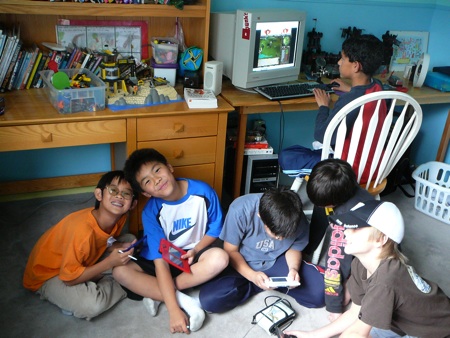Playing Digital Games Together
One of my biggest surprises as a parent has been to see how often video games and computer games turned into social events. I had been led by many media reports to believe that playing video games was an anti-social act. So when our kids turned player age, I was expecting to see them hide away while playing games. Sure, that does happen, but more often their choice is to play games — whether video, computer, or with balls outside — with their friends.

Game boys, including my son, playing video games — all of them — together.
Contrary to the stereotype, I would often observe the “game boys” play their Game Boys in a circle next to each other. Or they’ll play console games in a bunch. Even when only one computer is available, they’ll either a) look over the shoulder of the one playing, giving advice, or b) log on and use the video conferencing software to play “together.” One channel is for talking (and on the Mac up to three of them can videoconference at once), one channel for IMing, and one channel is for exploring the game with shared virtual characters. Most multi-player games (like Runescape and WoW) have built in chat, so there is constant virtual togetherness.
It has become clear to me that if both the very young, the hip young, and old have a choice they all would much prefer to play virtual games in a room together, or together outside if the technology allowed it. They don’t want the games to be anti-social, and I don’t think the technology wants that either.

Jeanne Gildea, 81, at a retirement community in Silver Spring, Md., enjoying Wii, which has expanded gaming’s reach.
Today’s New York Times offered an article making the same claim. It points out that some of the best selling games now are inherently social, The Nintendo Wii and Guitar Hero are just two examples of devices that want to be used with others.
Ever since video games decamped from arcades and set up shop in the nation’s living rooms in the 1980s, they have been thought of as a pastime enjoyed mostly alone. The image of the antisocial, sunlight-deprived game geek is enshrined in the popular consciousness as deeply as any stereotype of recent decades.
That’s changing. Online PC games in which thousands of players gab and explore together are attracting tens of millions of subscribers. Back in the living room, Nintendo’s revolutionary Wii system has helped forge a new audience for gaming among families, women and older people, who had been turned off by the complex, violent and solitary adventures that once dominated the market.
The piece by Seth Scheisel ends with this insightful summary:
If new acceptance by the masses is one pillar of gaming’s future, gaming’s emergence as a social phenomenon is the other. Hard-core gamers are still willing to spend 30 hours playing alone through a single-player story line, but most people want more human contact in their entertainment.
That is why World of Warcraft, the king of online games, now has more than 10 million users. That is why Guitar Hero is now a fixture on campus. That is why Nintendo has become the dominant mass-market game company.
I suggest that in another ten years when we hear the world digital game we will immediately assume that it involves more than one person playing. In fact rather than call some games “multi-player,” we’ll have to go in the other direction and use the qualifier “uni-player” to indicate we mean those few games one plays alone.


